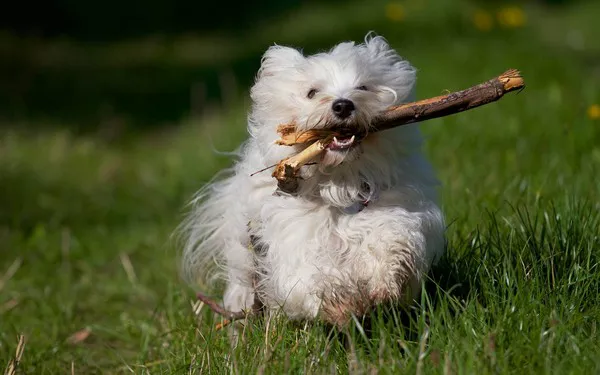Schnauzers, with their distinctive beards and eyebrows, have a bold look that matches their spirited personalities. Known for their intelligence and spunky nature, Schnauzers make for excellent companions, but potential dog owners often wonder: are Schnauzers hyperactive? This article will explore the energy levels of this beloved breed, distinguishing between natural liveliness and problematic hyperactivity. We’ll also discuss how to properly manage their energy through training, exercise, and mental stimulation to ensure a happy, well-behaved dog.
Understanding Schnauzer Temperament: Spirited, Not Hyperactive
Schnauzers come in three different sizes: Miniature, Standard, and Giant. Although they vary in size, Schnauzers share many personality traits, including their energetic disposition, intelligence, and strong-willed nature. While they are lively dogs, labeling them as “hyper” might not be entirely accurate.
It’s important to differentiate between a dog that’s high-energy and one that is hyperactive in a way that negatively affects their well-being or that of their owners. Many dogs, including Schnauzers, are bred for specific tasks, such as herding, guarding, or hunting, and their energy levels reflect their working roots.
What Is Hyperactivity in Dogs?
In the context of dog behavior, hyperactivity refers to an excessive amount of physical activity or over-excitement that often becomes problematic for the dog and their owners. It is typically accompanied by behaviors such as:
- Inability to settle down or rest
- Constant jumping, barking, or pacing
- Difficulty focusing on commands or tasks
- Over-excitement in response to minor stimuli
Dogs that exhibit hyperactivity may have underlying issues such as anxiety or a lack of mental and physical stimulation. It’s crucial to understand that some breeds are naturally more energetic, but hyperactivity can be managed or even prevented with the right approach.
Are Schnauzers Hyper Dogs?
While Schnauzers are known for their lively and active nature, it would be unfair to generalize the breed as hyper. Rather, they can be described as energetic, alert, and sometimes demanding of attention, but this is not the same as uncontrollable hyperactivity.
Miniature Schnauzers: Compact But High-Energy
Miniature Schnauzers, the smallest of the three, are often perceived as the most hyper of the breed. However, their high energy levels are generally a reflection of their enthusiastic and curious nature. Bred initially to hunt rats and other small vermin, Miniature Schnauzers are fast, agile, and incredibly tenacious. They love to be involved in everything their owners do and require regular physical activity and mental engagement.
Without sufficient exercise, these small dogs can become restless, leading to behaviors that may seem hyperactive. Fortunately, with regular walks, playtime, and mental stimulation, Miniature Schnauzers can channel their energy positively and thrive as happy, well-adjusted pets.
Standard Schnauzers: Balanced and Athletic
Standard Schnauzers sit in the middle of the size spectrum but bring a lot of energy to the table. Known for their versatility and working-dog history, they have a strong drive to stay active and engaged. These dogs are athletic and love physical activities, but with consistent training and adequate stimulation, they are less likely to exhibit what owners might describe as hyperactivity.
Due to their intelligence and eagerness to work, Standard Schnauzers benefit from activities such as agility training, obedience classes, or even herding exercises. A Standard Schnauzer that is well-exercised and mentally stimulated will likely be a calm and happy companion.
Giant Schnauzers: Large, Powerful, and Focused
Giant Schnauzers, while large and powerful, tend to have a more composed demeanor compared to their smaller counterparts. Though they are high-energy and require regular exercise, they often have a more balanced temperament. However, because of their size, when a Giant Schnauzer is not adequately exercised, they can develop behavioral issues that might be mistaken for hyperactivity. These issues can include destructive chewing, digging, or over-excitement indoors.
With their strong work ethic, Giant Schnauzers excel in activities such as cart-pulling, protection work, and advanced obedience training. Their energy levels are best managed through structured exercise routines, which help keep their natural liveliness in check.
The Importance of Exercise and Mental Stimulation
One of the main reasons why Schnauzers may appear hyperactive is a lack of appropriate physical and mental stimulation. Schnauzers are intelligent, working dogs that thrive when given tasks to perform, whether it’s learning new commands, engaging in play, or exercising.
How Much Exercise Do Schnauzers Need?
The amount of exercise a Schnauzer needs depends on its size and age. However, as a general rule:
Miniature Schnauzers need at least 30-60 minutes of exercise per day.
Standard Schnauzers require around 60-90 minutes daily.
Giant Schnauzers need 90 minutes to two hours of physical activity each day.
This exercise can be broken up into walks, play sessions, and other activities like hiking or running. These dogs also enjoy games that challenge their intelligence, such as puzzle toys, hide-and-seek, or training sessions that require focus.
Mental Stimulation: Keeping Schnauzers Engaged
Schnauzers are highly intelligent dogs that crave mental stimulation. Without mental challenges, they can become bored, which can manifest as restlessness or even destructive behavior. Engaging their brains is just as important as physical exercise to keep them well-balanced.
Here are some effective ways to provide mental stimulation for Schnauzers:
Puzzle Toys: Interactive toys that require the dog to solve problems to receive a treat.
Obedience Training: Regular training sessions that teach new commands or reinforce existing ones.
Agility Courses: Physical and mental challenges that require dogs to think and act quickly.
Interactive Play: Games like fetch, tug-of-war, or hide-and-seek can keep their minds sharp and engaged.
By combining physical and mental stimulation, you can manage your Schnauzer’s energy levels and prevent them from becoming overly excitable.
Socialization: Preventing Hyperactivity Through Positive Interaction
Proper socialization is essential for preventing hyperactive behavior in Schnauzers. If a dog is not adequately socialized, they can become anxious or overly excited in new situations or when encountering other dogs and people. Schnauzers, being naturally alert and protective, may react strongly if they aren’t accustomed to a variety of environments.
Socializing Schnauzer Puppies
Start socialization as early as possible with Schnauzer puppies to reduce the chances of developing anxiety-based hyperactivity later in life. Expose them to different sights, sounds, people, and animals in a controlled and positive way. Puppy socialization classes are a great way to introduce your dog to others in a supervised environment while reinforcing good behavior.
Continued Socialization for Adult Schnauzers
Even adult Schnauzers benefit from ongoing socialization. Regular walks in different locations, playdates with other dogs, and exposure to various stimuli help keep them calm and well-adjusted. When a dog is confident and comfortable in their environment, they are less likely to display hyperactive or reactive behavior.
Nutrition and Hyperactivity: Does Diet Play a Role?
Diet plays a significant role in your Schnauzer’s overall behavior and energy levels. Just like humans, dogs can be affected by the food they consume, and certain ingredients or feeding practices may contribute to hyperactivity.
Avoiding High-Sugar Foods
Some commercial dog foods contain artificial additives, preservatives, and excessive amounts of sugar, which can lead to spikes in energy. These energy surges may manifest as hyperactive behavior, especially in a naturally energetic breed like the Schnauzer. Feeding your dog a well-balanced, high-quality diet with whole ingredients can help maintain stable energy levels.
Feeding Schedule
In addition to what you feed your Schnauzer, how often you feed them can impact their behavior. Feeding them smaller meals more frequently throughout the day can help prevent energy spikes and keep their blood sugar levels stable. Always consult with your veterinarian to determine the best feeding schedule for your dog’s age, weight, and activity level.
See Also: Are Schnauzers Good for First-Time Owners?
Training Techniques to Manage Hyperactive Behavior
Training plays an essential role in managing your Schnauzer’s behavior. An untrained Schnauzer, especially one that isn’t given adequate outlets for its energy, may exhibit behaviors that resemble hyperactivity. Consistent and positive training helps establish boundaries and gives your dog clear expectations.
Obedience Training
Basic obedience training should be started early and reinforced throughout the dog’s life. Commands such as “sit,” “stay,” and “come” are fundamental for controlling an excitable dog. Schnauzers are highly trainable due to their intelligence, but they can be stubborn, so patience and consistency are key.
Crate Training for Calmness
Crate training can also be an effective tool in managing hyperactivity. A crate provides your dog with a safe and quiet space to retreat to when they are feeling overstimulated. When properly introduced, a crate can become a place where your Schnauzer can rest and self-regulate.
Redirecting Hyper Behavior
If your Schnauzer exhibits hyper behavior, such as jumping on guests or barking excessively, it’s important to redirect that energy. Offering them a toy or asking them to perform a command, like “sit,” can refocus their attention and provide them with a more appropriate outlet for their energy.
Anxiety and Hyperactivity: Could Stress Be the Culprit?
In some cases, what appears to be hyperactivity in a Schnauzer may actually be anxiety. Dogs, like humans, can experience stress and anxiety, which can lead to behaviors like pacing, excessive barking, and an inability to settle down. Common causes of anxiety in Schnauzers include:
- Separation anxiety
- Loud noises, such as thunderstorms or fireworks
- Changes in routine or environment
Signs of Anxiety in Schnauzers
It’s important to distinguish between a dog that is simply energetic and one that is anxious. Signs of anxiety in Schnauzers may include:
- Panting or shaking
- Destructive behavior (chewing furniture, digging)
- Excessive licking or grooming
- Hiding or clinging to their owner
If you suspect your Schnauzer’s hyperactivity is due to anxiety, addressing the root cause is crucial. This may involve training, providing a more predictable routine, or consulting with your veterinarian for advice on managing anxiety.
When Hyperactivity Becomes a Concern
While most Schnauzers can manage their energy levels with proper care, there are cases where hyperactivity may indicate a deeper issue. If your dog’s behavior is disruptive, destructive, or causing stress for you and your family, it may be time to seek professional help.
Consult a Veterinarian or Behaviorist
In some cases, hyperactivity in dogs can be linked to underlying medical conditions, such as thyroid imbalances or neurological issues. A visit to the veterinarian can help rule out any health problems contributing to the behavior. Additionally, a certified dog behaviorist can provide insights into managing excessive energy through specialized training techniques.
Patience and Persistence
Managing a high-energy dog like a Schnauzer takes patience, persistence, and a commitment to their well-being. Remember, every dog is unique, and what works for one may not work for another. It’s important to remain consistent with training, exercise, and care routines to see lasting improvements in your Schnauzer’s behavior.
Conclusion
In conclusion, Schnauzers are energetic, lively, and intelligent dogs that need plenty of physical exercise and mental stimulation. While they may sometimes exhibit behaviors that seem hyperactive, they are not inherently hyper dogs. With the right care, training, and attention, Schnauzers can be wonderful companions, full of personality and charm, without overwhelming their owners.
Proper socialization, consistent training, regular exercise, and a balanced diet are key factors in managing your Schnauzer’s energy levels. If hyperactive behaviors persist despite these efforts, it’s worth consulting with a veterinarian or behaviorist to explore potential underlying causes and solutions.
Related Topics:























